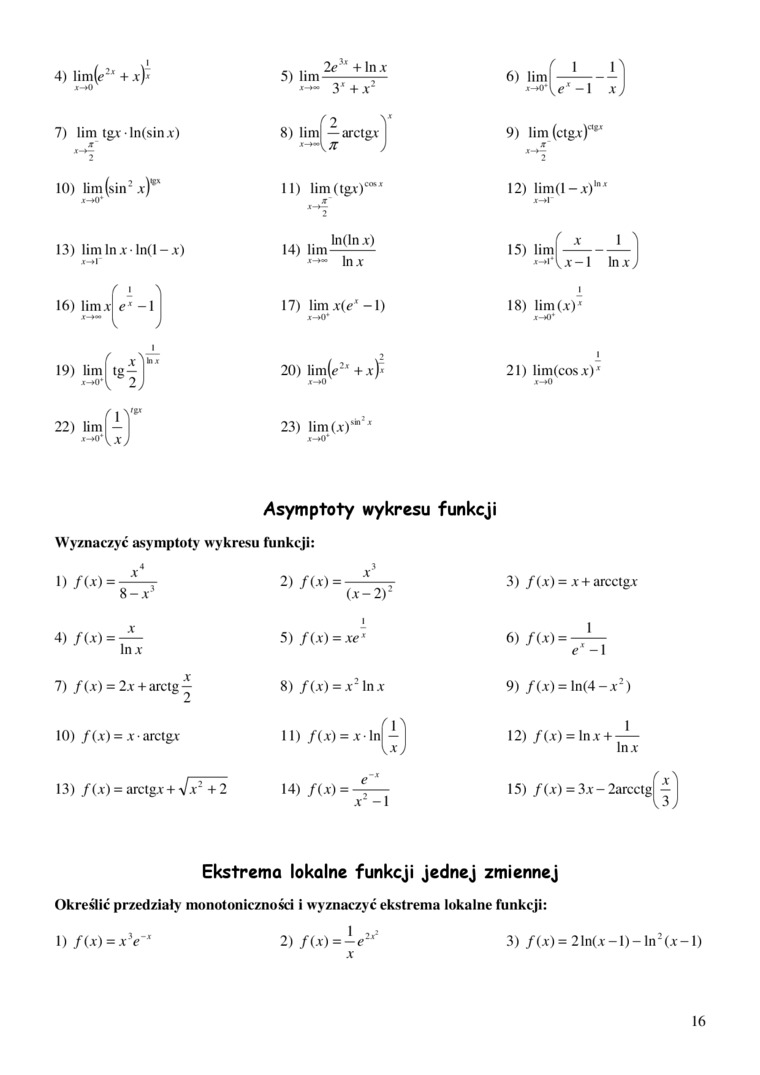18774

5) lim
4) lim(e2* + .v)
x —*0
7) lim tg* ln(sin*)
X~
X~*2
2e + ln.v
3‘ +*2
8) lim^—arctgrj
6) limf—-----
-I *
9) lim (etg*)ct*‘
X’
x-»—
2
10) lim (sin2*)**
j-»0*
13) lim In*- ln(l -*)
11) lim (tg*)c<“
X
x-+—
2
.... ln(ln *)
14) lim-
In *
12) lim(I-jr)1
x-+l'
15) lim
*-*i
imf—---— 1
-*'A*-1 ln*J
16) lim*
( i
ex -1
17) lim *(*■*-1)
x-*0'
18) lim (.v)
x-*0‘
19) lim
j—*0'
22) lim
x-*0'
20) lim(e2* + *)*
21) lim(cos*)'
x-*0
23) lim(*)‘
x-»0*
Asymptoty wykresu funkcji
Wyznaczyć asymptoty wykresu funkcji:
|
X |
f(v\- x |
3) /(*) = * + arcctg* |
|
8-*3 | ||
|
X In a |
i 5) f(x) = xe~* |
6) fw=-^— € - 1 |
|
. X = 2* + aretg — 2 |
8) /(*) = *2In* |
9) /(*) = ln(4-*2) |
|
= a • aretg* |
II) /(jt) = Jt-ln^j |
12) /(*) = ln* + — In* |
|
= aretg* + V*2 + 2 |
14) f(x) = -4—— *' “I |
15) /(*) = 3* - 2arcctg| |
C
K | m
1) f(x)
4) /(*) =
Ekstrema lokalne funkcji jednej zmiennej
Określić przedziały nionotoniczności i wyznaczyć ekstrema lokalne funkcji:
1) /(*) = * V
3) /(*)= 21n(*-l)-ln:(*-l)
16
Wyszukiwarka
Podobne podstrony:
IMG 29 i Zadania 1 c) lim (cos x) x ; ... x — arctgrr e) lim- *->0 x2 d) lim x arc ctgz; X—►OO
019(1) 3) Jeżeli x -» O, to ^ -» oo i arc tg nie dąży do żadnej określonej wartości, czyli lim arc t
IMG 29 i Zadania 1 c) lim (cos x) x ; ... x — arctgrr e) lim- *->0 x2 d) lim x arc ctgz; X—►OO
image69 sin( &+ Ą = cos(&+ /?} ■ tg[ &+ Ą = ctg[ a>+ Ą ■■ sin L-ycos^+ cos ^rsin $ =
skan0005 20.y = 22.2/ = 26.2/ 2 _ -1 13. y2 ■ ®9 + b + O IB. y2 = ln
str028 (5) 28 1. ELEMENTY TEORII FUNKCJI ZMIENNEJ ZESPOLONEJ (4.10) e2 + 2*!ti _ gZ ^ (4.11) sin (z
3. tg ci ’ Sin 2, CL COS d - { 2h(2.-2. )- ł^-łŁ) L)= X-2_ r -2*. f x^*ł a.* % *
str 2 arctgx = - ■/3 D = <=» x = s/3 — arc tg x) dx 1.0 pt. 0.5 pt. arc tg x dx = x arc tg x — ^
tabela wartości funkcji trygonometrycznych Tabela wartości funkcji trygonometrycznych a sin a cos
19. Sporządzić wykresy funkcji a) y-tg{*- ZA),i>) y = sin
CCF20110115�020 13 Analiza stateczności nasypu na podłożu organicznym • (ć-l • sin a - u • / • tg tf
więcej podobnych podstron